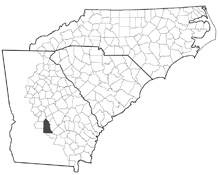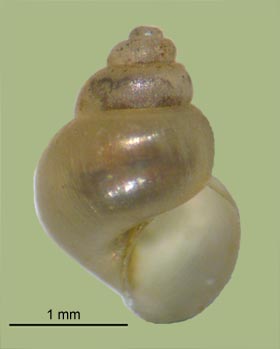> Habitat & Distribution
This is another of three nominal species of hydrobiid gastropods endemic (or nearly endemic) to springs and spring-fed tribuarties of the Ocmulgee River in the vicinity of Hawkinsville, GA. Populations of M. agarhecta inhabit clear water with a slight current, predominantly in diatomaceous ooze on top of submerged logs, and less commonly in silt containing large amounts of diatoms (Thompson 1969, Thompson 1977, Watson 2000). FWGNA incidence rank I-1, rare.
> Ecology & Life History
Hydrobiids seem to be rather nonspecific grazers of small particles (Dillon 2000: 94-97). They are typically dioecious, the males being characterized by a penis that arises from the neck. Females attach single eggs in spare, hemispherical capsules to solid substrates (Hershler 1994). No specific life history data are as yet available for M. agarhecta.
> Taxonomy & Systematics
Like Spilochlamys,
Notogillia,
and Floridobia,
the genus Marstonia
belongs to the subfamily Nymphophilinae of the family
Hydrobiidae (ss), males being
characterized by a lobe-shaped penis (or verge) with surficial
glandular patterns (Kabat and Hershler 1993, Hershler et al. 2003,
Thompson 2004). The penis of M. agarhecta has
been figured by Thompson (1969).
 Marstonia is
strikingly distinct from Notogillia
and Spilochlamys
on the basis of shell morphology. The difference between M. agarhecta from
the vicinity of Hawkinsville and M.
gaddisorum
from Laurens County is not obvious, however. Nor did the
mtDNA
study of Hershler et al. (2003) return evidence of substantial genetic
divergence between agarhecta
and gaddisorum.
Marstonia is
strikingly distinct from Notogillia
and Spilochlamys
on the basis of shell morphology. The difference between M. agarhecta from
the vicinity of Hawkinsville and M.
gaddisorum
from Laurens County is not obvious, however. Nor did the
mtDNA
study of Hershler et al. (2003) return evidence of substantial genetic
divergence between agarhecta
and gaddisorum.
Baker (1926) originally proposed Marstonia as a subgenus of Amnicola. Thompson (1969, 1977) redefined and expanded the taxon, placing several newly-described southeastern species in it. Hershler and Thompson (1987) synonymized Marstonia under Pyrgulopsis on the basis of similarities in penial morphology. But after review of female reproductive anatomy, Thompson and Hershler (2002) resurrected Marstonia to generic status and allocated to it all eastern North American species previously placed in Pyrgulopsis. Female reproductive anatomy, specifically occurrence of a large extension of the albumen gland into the pallial roof, is a distinctly Marstonia characteristic (Hershler 1994, Hershler et al. 2003). Recent molecular-based phylogenetic analyses has also supported the distinction between Marstonia and Pyrgulopsis (Liu and Hershler 2005).
> Maps and Supplementary Resources
> Essays
- Earlier versions of this website, online until August of 2016, adopted the large, broadly-inclusive concept of the Hydrobiidae (sl) following Kabat & Hershler (1993). More recently the FWGNA project has shifted to the Wilke et al. (2013) classification system, distinguishing a much smaller Hydrobiidae (ss) and elevating many hydrobioid taxa previously ranked as subfamilies to the full family level. For more details, see The Classification of the Hydrobioids.
> References
Baker, F.C. (1926)
Nomenclatural notes on American fresh water Mollusca. Transactions of
the Wisconsin Academy of Sciences, Arts, and Letters
22:193-205.
Dillon, R. T., Jr. (2000)
The Ecology of Freshwater Molluscs. Cambridge, Cambridge University
Press. 509 pp.
Hershler, R. (1994)
A review of the North American freshwater snail genus Pyrgulopsis
(Hydrobiidae). Smithsonian Contributions to Zoology 1994;
0(554):1-115.
Hershler, R., H. Liu, and
F.G. Thompson (2003)
Phylogenetic relationships of North American nymphophiline gastropods
based on mitochondrial DNA sequences. Zoologica Scripta
32:357-366.
Hershler, R., and F.G.
Thompson (1987) North American Hydrobiidae
(Gastropoda: Rissoacea): redescription and systematic relationships of Tryonia Stimpson,
1865 and Pyrgulopsis
Call and Pilsbry, 1886. The Nautilus
101:25-32.
Kabat, A.R., and R.
Hershler (1993)
The prosobranch snail family Hydrobiidae (Gastropoda: Rissooidea):
review of classification and supraspecific taxa. Smithsonian
Contributions to Zoology 547:1-94.
Liu, H., and R. Hershler
(2005)
Molecular systematics and radiation of western North American
nympholine gastropods. Molecular Phylogenetics and Evolution
34:284-298.
Thompson, F.G. (1968)
The
Aquatic Snails of the Family Hydrobiidae of Peninsular Florida.
University of Florida Press, Gainesville, Florida,
USA.
Thompson, F.G. (1969)
Some
hydrobiid snails from Georgia and Florida. Quarterly Journal of the
Florida Academy of Sciences 32:241-265.
Thompson, F.G. (1977)
The hydrobiid snail genus Marstonia.
Bulletin of the Florida State Museum 21(3):113-158.
Thompson,
F.G. (2004) An identification manual for the
freshwater snails of Florida.
Watson, C. N.
(2000)
Results of a survey for selected species of Hydrobiidae (Gastropoda) in
Georgia and Florida. pp. 233 - 244 in Freshwater Mollusk
Symposium Proceedings (Tankersley et al, eds) Ohio Biological
Survey, Columbus.
Thompson, F. G. &
R. Hershler (2002) Two genera of North American
freshwater snails: Marstonia
Baker, 1926, resurrected to generic status, and Floridobia, new
genus (Prosobranchia: Hydrobiidae: Nymphophilinae). The
Veliger 45: 269 - 271.
Wilke T., Haase M., Hershler R.,
Liu H-P., Misof
B., Ponder W. (2013)
Pushing short DNA
fragments to the limit: Phylogenetic relationships of “hydrobioid”
gastropods
(Caenogastropoda: Rissooidea). Molecular
Phylogenetics and Evolution 66: 715 – 736.








